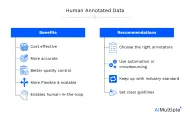Customers have more options than ever due to increasing competition and the quality of customer service has become one of the key factors for businesses to stay ahead of the competition.
This article, we will explore one of the techniques used in these applications: intent classification.
What is intent classification?
Intent classification (sometimes called intent recognition) is a technique used in natural language processing (NLP). Intent classification analyzes the intentions behind texts and categorizes them such as requests or approvals.
How does intent classification work?
Intent classification takes the written or spoken texts as input and uses ML and NLP techniques to assign every single word to their intent automatically.
- The input can be in the form of text or speech. Speech input must be converted to text form with speech-to-text technology, such as an automated speech recognition.
- Intents that are appropriate for the use case should be determined.
- Then, intent classifiers are trained and text is labeled with intents. For example, the sentence “I want to chat with David” indicates a request and can be tagged as such.
How can business get benefit from intent classification?
- Intent classification are used in conversational AI applications to provide personalized conversation experiences to users. It helps to increase sales and improve overall customer experience. It allows businesses to understand customers’ intent and give a more accurate response to their customers.
- It can allow businesses to automate the interaction between interested buyers and business representatives. It classifies customers’ needs and their special attention then analyzes what customers intend to achieve, and directs them to the relevant representative by categorizing customers’ intents.
Further reading
- Data Annotation: What it is, Why it matters, and Implementations
- Data Labeling: How to Choose a Data Labeling Partner
If you have other questions about intent classification and which solutions to choose, we can help:


Comments
Your email address will not be published. All fields are required.